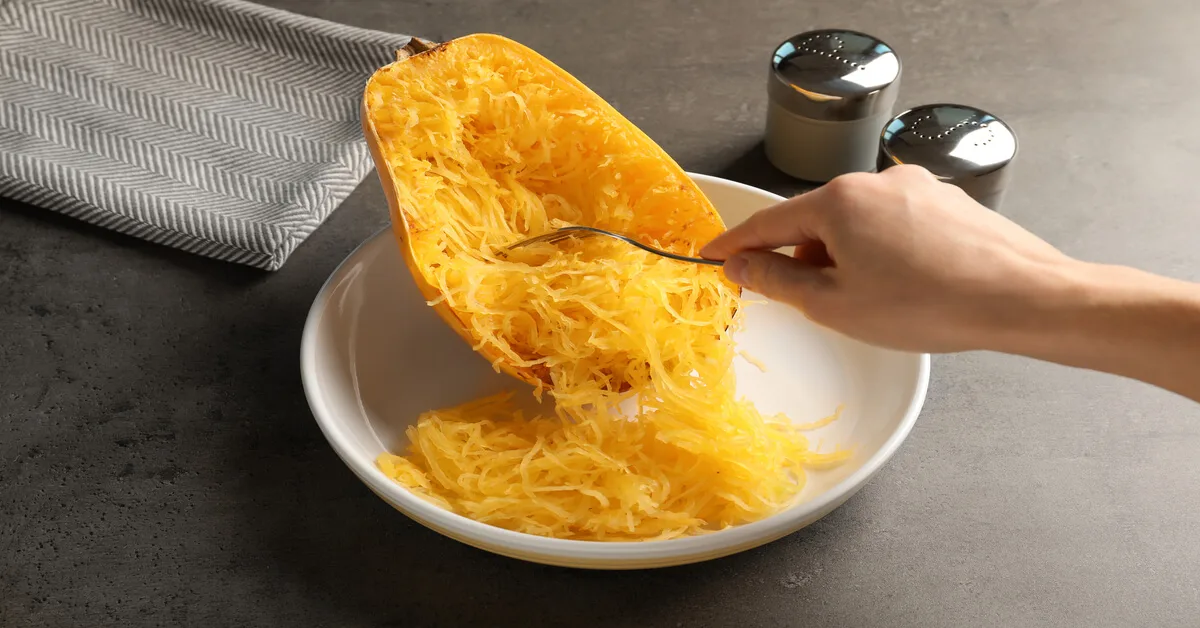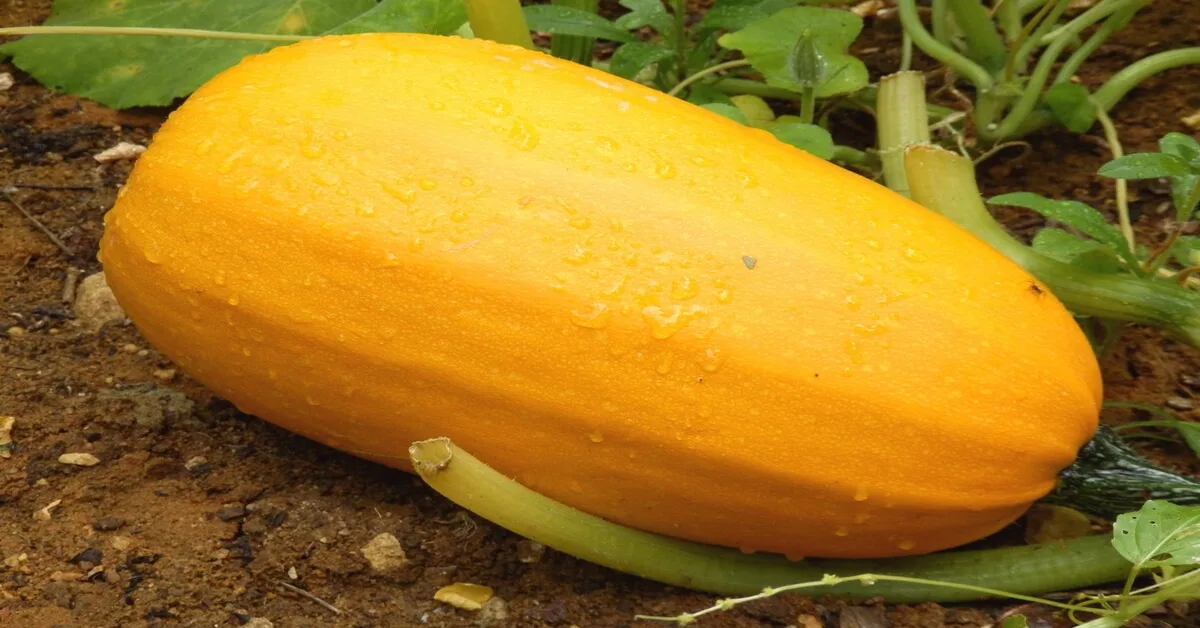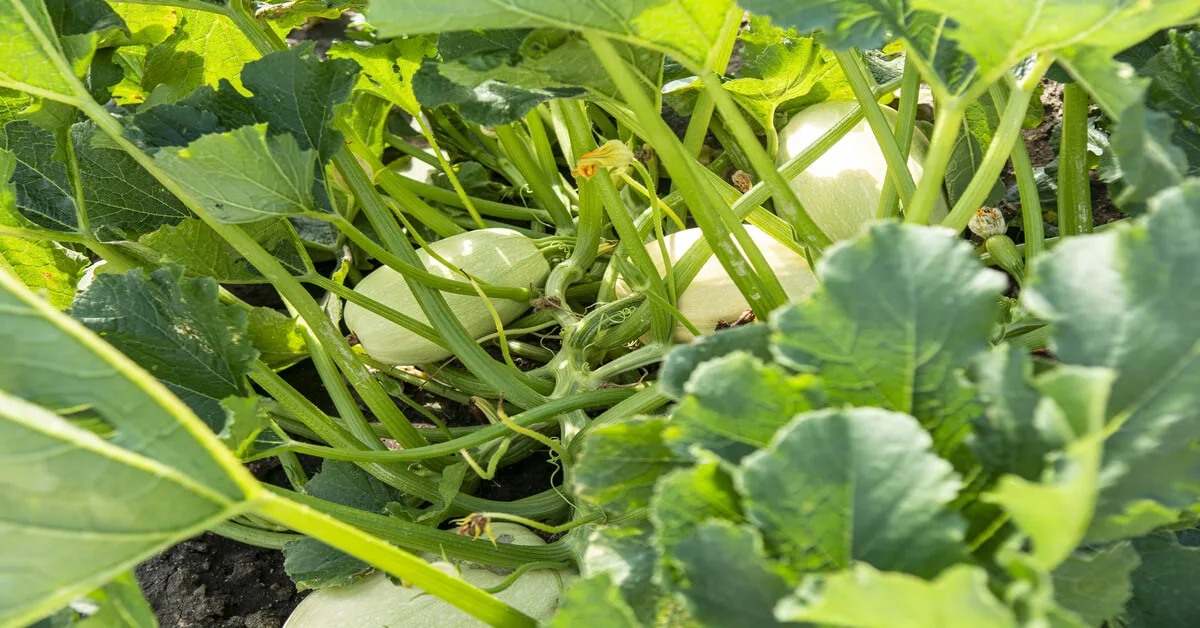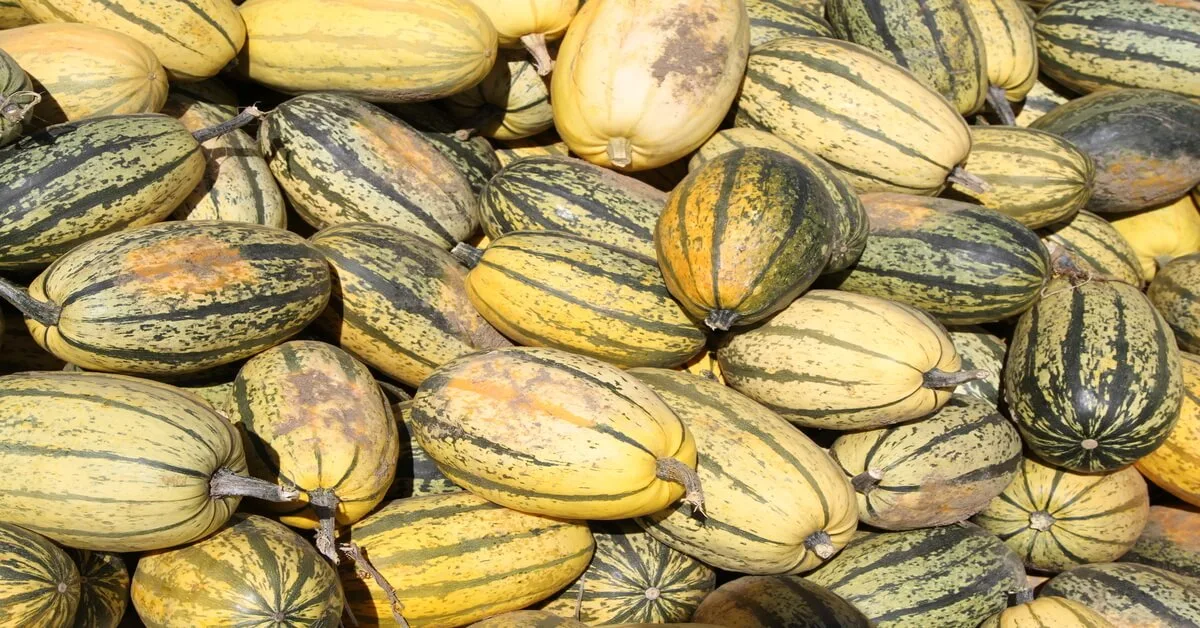Some of the links in this post are affiliate links. This means if you click on the link and purchase the item, I will receive an affiliate commission at no extra cost to you.
Spaghetti squash (Cucurbita pepo subsp. pepo) is an annual vegetable crop. It is a member of the gourd family Cucurbitaceae. Though it is referred to as a vegetable in the kitchen, spaghetti squash is a fruit.
Unlike patty pan squash, spaghetti squash is a winter squash. Winter squash is harvested when they are mature. This causes them to have a thicker rind and fully formed seeds.
In this article, you’ll learn everything you need to know about how to grow spaghetti squash. We’ll even tell you about some of the different types and what plants grow best with them.
What Is Spaghetti Squash?

Spaghetti squash is a type of winter squash that has a thick white to orange rind. When cooked correctly, the inner falls apart into long strands of vegetable spaghetti.
It has a mild flavor and stringy texture. That’s why it is often used as a low-calorie alternative to traditional spaghetti.
Even though spaghetti squash is called a winter squash, you don’t grow it in winter. Winter squash types are harvested when fruits are mature. The thicker rinds allow you to store them for up to a few months.
That means if you plant winter squash in the fall, you could store and eat it during the winter months. Summer squash, like yellow crookneck squash, is harvested early when the rinds are still thin. Unlike winter squash, they can only be stored for a week or two.
Spaghetti Squash Plant Care

Spaghetti squash is not difficult to grow and does well in USDA hardiness zones 2 to 11. Providing enough water and nutrients are the two most important factors to consider.
Temperature, diseases, and insects tend to be the biggest problems for spaghetti squash. Below we provide tips on how to avoid these issues.
Soil
You need well-draining soil that can retain moisture for spaghetti squash. Soil high in organic matter works best because it provides extra nutrients.
If you have sandier soil, adding organic matter can help it retain moisture better. If you have clayey soils, tilling in some organic matter will help with drainage. Add a layer of mulch to the soil to help with moisture retention and reduce weed growth.
Watering
Make sure to keep the soil consistently moist throughout the entire growing season. Plants should get at least 1 inch of water per week.
When hand watering, avoid wetting the leaves or fruit. Water on leaves and fruit can lead to disease issues. Water in the morning so that if any plant tissue gets wet, the sun will quickly dry it.
Lighting
Spaghetti squash needs full sun to grow well. That means they need at least 6 hours of direct sunlight each day.
Humidity & Temperature
Spaghetti squash plant temperature should be between 70 and 90 degrees Fahrenheit. Temperatures above 90 degrees Fahrenheit can cause the flowers to drop off early. Use shade cloth to protect flowering plants if temperatures are too high.
Frost will kill spaghetti squash plants. Make sure you don’t sow seeds until two weeks after the last predicted frost date.
The ideal humidity for spaghetti squash is 60 percent. This allows the soil to retain moisture better without increasing disease issues.
Fertilizing
Squash plants are heavy feeders and require more nutrients to grow well. Spaghetti squash does best when 2 to 3 plants are grown together on a mound.
Before planting, add 2 or 3 tablespoons of 10-10-10 fertilizer evenly over each mound. Mix the fertilizer into the soil to a depth of about 4 inches.
Add two more tablespoons of 10-10-10 fertilizer around each mound when flowers appear. Make sure it doesn’t touch the plants and water them immediately.
Diseases & Pests
Like other squash plants, several diseases and insect pests impact spaghetti squash. Avoid getting leaves and fruit wet to reduce disease issues.
Check for any insect or disease damage each time you water. The sooner you detect a problem, the easier it is to deal with.
It is recommended to keep young spaghetti squash plants under row covers. This will keep insects away. Make sure to remove row covers when flowering begins so they can be pollinated.
Diseases that impact spaghetti squash include blossom-end rot, cucumber mosaic virus, downy mildew, and powdery mildew.
Insects that feed on spaghetti squash include aphids, cucumber beetles, squash bugs, squash vine borers, and stink bugs.
Days To Maturity
Most spaghetti squash plants take about 80 to 100 days to bear mature fruit. Some varieties mature slightly quicker or slower. Environmental factors like temperature can also impact how quickly they mature.
Harvesting
Unlike summer squash, spaghetti squash isn’t ready to harvest until the rind is hardened. The leaves of the plant will begin to brown and dry out along with the vine. If you can damage the rind with a fingernail, it’s not ready to be harvested.
When removing spaghetti squash from the vine, use a pair of hand pruners or a sharp knife. Leave at least two inches of stem on the fruit. This will help you avoid damaging the fruit’s rind in any way when removing it from the vine.
Spaghetti squash will yield about 3 to 7 fruits per plant depending on the variety. This may not seem like much but each fruit typically weighs 3 to 5 pounds. Make sure you cure your spaghetti squash before storing it.
Curing
Winter squash needs to be cured so it can be stored for several months. If the weather is still dry and warm, you can allow spaghetti squash to cure on the vine. Otherwise, bring them inside and leave them in a warm spot like a window seal to dry out.
Curing takes about 7 to 10 days after the fruit is fully mature. After the spaghetti squash cures, rinse it. Use diluted bleach water to remove any fungi or bacteria.
One cup of bleach to 10 cups of water works well. This should make enough solution to submerge each fruit in.
Allow the spaghetti squash to air dry after washing. Then store it in a cool dry place until you’re ready to use it. Most spaghetti squash will last for a few months if stored at 40 to 50 degrees Fahrenheit.
How To Plant Spaghetti Squash

Don’t plant spaghetti squash outside until two weeks after the threat of frost has passed. When you plant spaghetti squash too early, frost will kill the seedlings.
These plants do best when seeds are sown outdoors known as direct sowing. If you have a short growing season, you can start seeds inside and then transplant them.
Use biodegradable seed starter trays if you need to transplant your spaghetti squash. With these papery trays, you can tear the pots away instead of pulling the transplants out of them. This will reduce the chance of disturbing the roots which can easily kill the plant.
Spaghetti squash does best when planted on mounds. This helps ensure the soil drains well. Mounds should be 3 to 6 feet apart. Make sure to install a trellis before planting when growing vining varieties.
When directly sowing seeds, plant 5 to 6 seeds per 1-foot wide mound. Plant the seeds 1 inch deep and 2 to 3 inches apart.
When seedlings are 3 inches tall, thin them out to 2 or 3 plants per mound. Remove plants by cutting them with scissors so you don’t disturb the roots of the seedlings you’re keeping.
Keep only the healthiest-looking seedlings. When transplanting, plant 2 to 3 seedlings per mound.
Succession planting spaghetti squash is highly recommended. It will extend the harvesting time as plants planted later will mature later.
Plant a second set of spaghetti squash in mid-summer. Not only will you enjoy a longer harvest, but this will also help you when it comes to pests and diseases.
Many pests of spaghetti squash are only present early in the season. If your early-season crop is damaged, the mid-season crop will likely perform better.
Spaghetti Squash Growing Stages
Germination is the first growing stage for spaghetti squash. Spaghetti squash seeds will germinate in 2 to 10 days depending on the soil temperature.
The seedling stage is the next growth stage and begins when the first set of true leaves emerge. When the plants germinate they have two small, round leaves. These are not true leaves.
Spaghetti squash will be seedlings for about 4 weeks. During this time they will put on several leaves and grow taller. The root system will also begin to expand.
Next is the vegetative stage when spaghetti squash vines will quickly spread. Bush types will begin producing new leaves rapidly. This stage lasts for 8 to 12 weeks depending on the weather.
Spaghetti squash plant size depends on the variety you plant. Bush varieties will reach around 3 feet in diameter and 2 to 3 feet tall. Vine varieties will grow as long as 10 feet.
The flowering stage begins when the plant begins to produce male and female flowers. Flowering usually only lasts for 2 to 3 weeks. If the female flowers are pollinated, the maturation stage begins.
During the maturation stage, the spaghetti squash fruits will begin to grow larger. It takes around 100 days to go from seed to full-ripened fruit. The leaves and stems will begin to dry out and die when the fruits are ready to harvest.
Types of Spaghetti Squash

There are many different varieties of spaghetti squash you can plant. Fruit can be smaller or larger and range in color from white to dark orange.
Vining varieties are much more common than bush varieties. If you have a smaller garden, you may want to consider planting a bush variety.
Below are a few of the most popular varieties of spaghetti squash. We’ve listed their growth form, fruit characteristics, and maturation rate. This will help you choose the best variety to meet your preferences.
| Name | Growth Form | Characteristics | Days to Maturity |
| Hasta La Pasta | Compact vines | Fruits 6 to 8 inches long and orange in color. Produces more fruit than most other varieties. | 73 |
| Small Wonder | Vine | Fruits 4 to 6 inches long, oval in shape, and light orange. | 75 to 80 |
| Tivoli | Bush | Fruit is light yellow in color and weighs up to 5 pounds when mature. Fruits store well after harvesting. | 98 |
| Vegetable Spaghetti | Vine | Fruits 8 to 10 inches long and tan in color. Each plant produces 5 to 7 fruits. | 88 to 110 |
Spaghetti Squash Companion Plants
Many companion plants for spaghetti squash are the same as those for other squash species like acorn squash and zucchini. They include cantaloupe, corn, beans, honeydew, lettuce, peas, pumpkin, radish, and watermelon.
Marigolds and nasturtiums may help to repel many common squash plant pests. Planting flowers nearby to attract bees can help with squash pollination. Some of the best flowers to use include cosmos, lantana, and zinnias.
Avoid planting potatoes or any Brassica species near your spaghetti squash. These vegetables are heavy feeders. They will compete with your squash for nutrients making it difficult for them to grow well.
Spaghetti Squash vs Butternut Squash
The main difference between spaghetti squash and butternut squash is their texture and taste. Spaghetti squash is stringy and has a very mild, nutty taste. Butternut squash has a creamy texture and a mild, sweet taste.
The shape and color of these two fruits also vary. Spaghetti squash is oval in shape and can be white to orange in color. Butternut squash is fatter on one end and has a tan rind.
References
[1] Cucurbita pepo L..Germplasm Resources Information Network (GRIN). Agricultural Research Service (ARS), United States Department of Agriculture (USDA). Retrieved 2023-02-06.

